
Welcome to my blog on how to use ChatGPT for essays!
You've been there, haven't you?
The relentless march of the clock, an impending essay deadline, and a blank screen mocking you with its emptiness.
Don't worry, my friend, for the future of essay writing has arrived in ChatGPT, a revolutionary artificial intelligence that is turning the academic world on its head.
Join me as I explore the essay-writing potential of ChatGPT as well as its limitations.
Let's dive in!
Understanding ChatGPT for Essay Writing
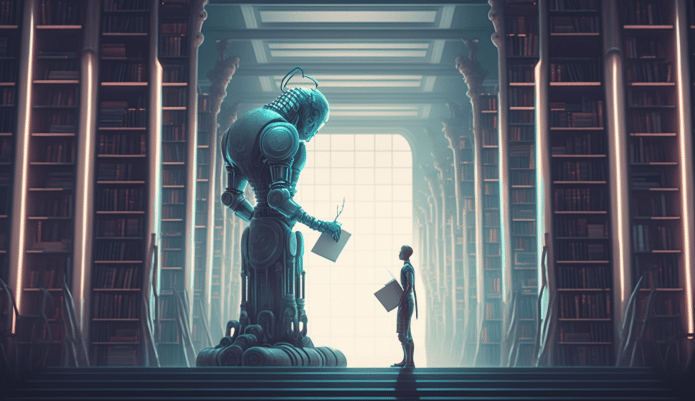
To truly appreciate the potential of ChatGPT, let's compare it with conventional essay writing methods, shall we?
ChatGPT vs. Traditional Essay Writing
The trials and tribulations of traditional essay writing cut deep: laborious research, organizing ideas, and crafting logical arguments, often at the expense of your sanity.
Enter ChatGPT, an intricate machine-learning language model that promises to lighten the load.
Provide your topic and key points, and this AI chatbot will generate a structured, coherent essay in the blink of an eye.
A tantalizing prospect, indeed.
But, will ChatGPT ever replace human writers? Time will tell.
Limitations and Ethical Considerations

As amazing as ChatGPT's capabilities might be, it's important not to get carried away. (You can read more on cool and creative ways to use ChatGPT here.)
There are limitations and ethical considerations that warrant our attention.
- Knowledge cutoff: ChatGPT's knowledge only extends until September 2021.
- Confident, incorrect answers: ChatGPT may generate convincing yet incorrect or nonsensical responses that require user verification.
- Sensitivity to input phrasing: ChatGPT can be sensitive to phrasing tweaks or multiple attempts, leading to output inconsistencies.
- Verbosity: ChatGPT can be verbose and overuse specific phrases.
- Bias: ChatGPT may exhibit biases from the data it's trained on.
- Critical thinking: AI lacks the human capacity for critical thinking.
- Plagiarism concerns: ChatGPT raises plagiarism concerns if AI-generated content unintentionally resembles existing sources.
It's also important to note that your institution may not accept AI-assisted work. Please note that this blog post doesn’t encourage you to break any rules.
Setting up ChatGPT

Now let's jump into the exciting part: setting up ChatGPT for your essay-writing needs.
Here's how to get started
- Navigate to chat.openai.com.
- Sign up: Provide your email address and create a password.
- Acquaint yourself: Familiarize yourself with the platform, usage guidelines, terms of service, and potential costs.
- Start writing: With a firm grasp of the platform, you can conquer the essay-writing world!
Make sure to keep reading our tips below!
Essay Brainstorming with ChatGPT
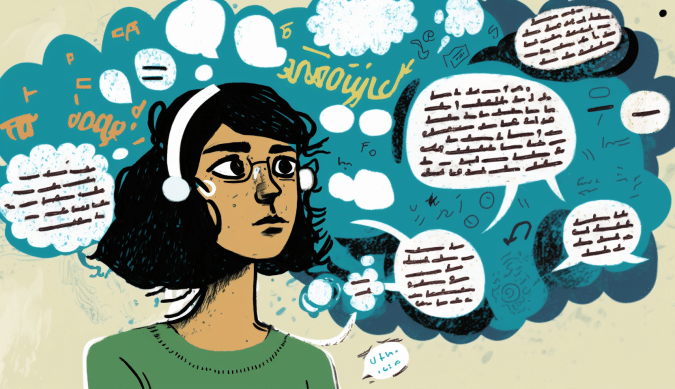
Let's dive into a simple yet effective strategy that will turn ChatGPT into your ultimate essay-brainstorming companion. These ideas stem from the University of North Carolina’s guide to brainstorming. Then, I infused my own knowledge of ChatGPT (I’ve been using the tool since its release).
We offer more tips on how to use ChatGPT for Brainstorming here.
Step 1: Start with a Clear and Focused Question
First, framing your question to encourage ChatGPT to offer diverse viewpoints is crucial. For example, instead of asking something generic like “What should I write about?” try formulating a more focused question, such as “What are some unique perspectives on climate change and its impact on agriculture?”
Step 2: Encourage Diverse Responses
Next, you'll want to nudge ChatGPT into providing a range of responses. Explicitly ask for multiple angles. For example, “Can you give me five different angles to explore the relationship between climate change and agriculture?” This way, you clarify that you're looking for variety in the AI's response.
Step 3: Iterate and Refine
Don't be afraid to dig deeper and ask follow-up questions to explore the subtopics ChatGPT suggests. If you receive an interesting angle but need more from the AI, simply ask for it! Remember, the more specific your questions are, ChatGPT will provide you with relevant insights beyond the surface level.
Step 4: Combine and Contrast Perspectives
Once you've gathered several angles, perspectives, or subtopics, think about how they might fit together in your essay. Are there any common themes or contrasting viewpoints? This step involves identifying connections and organizing the information you've gathered.
Step 5: Use Prompts to Spark Creativity
Finally, if you're stuck or want to push ChatGPT to think even more outside the box, try using prompts to encourage creative thinking.
For instance, you could ask, “How would an environmentalist, a farmer, and an economist each view the impact of climate change on agriculture?”
By posing the question this way, you're inviting ChatGPT to adopt distinct personas, which will naturally diversify the responses.
Crafting a Strong Thesis Statement

First, you might be wondering: what exactly is a thesis statement?
In a nutshell, it's a sentence (or two) that encapsulates your essay's main argument. It acts as a roadmap for your readers, guiding them through your paper with a clear focus.
You see, a well-crafted thesis statement keeps you on track while writing and helps your audience understand the direction of your work.
But how do you create a powerful thesis statement?
First, identify your topic clearly. This could be a subject you're passionate about, a problem you want to solve, or an issue you'd like to explore. The clearer your topic, the easier it will be to craft a strong thesis statement.
With your topic in hand, it's time to refine it. Again, avoid broadness and vagueness at all costs – specificity is key. Your goal is to create a focused scope for your essay.
Moving on, it's time to take a stand now that you've got a specific topic. What's your position on the issue? What's the central argument you want to make?
Experts like Jack Lynch from Rutgers University suggest composing a controversial thesis. In other words, your thesis should be debatable, allowing others to disagree (or agree) with it. Be bold and assertive while keeping it concise. Aim for a single, impactful sentence.
Understanding these principles is critical, as we will use them as parameters for ChatGPT.
I recommend looking at this Harvard Writing Center resource to develop a thesis.
Crafting a Thesis with ChatGPT
Here's how you could create a powerful thesis statement using the steps above.
To kick things off, ask ChatGPT for ideas on potential topics related to your subject of interest. The goal here is to spark inspiration.
“Please offer some exciting essay topics related to social media. They should be based on the hottest talking points or most controversial storylines.”
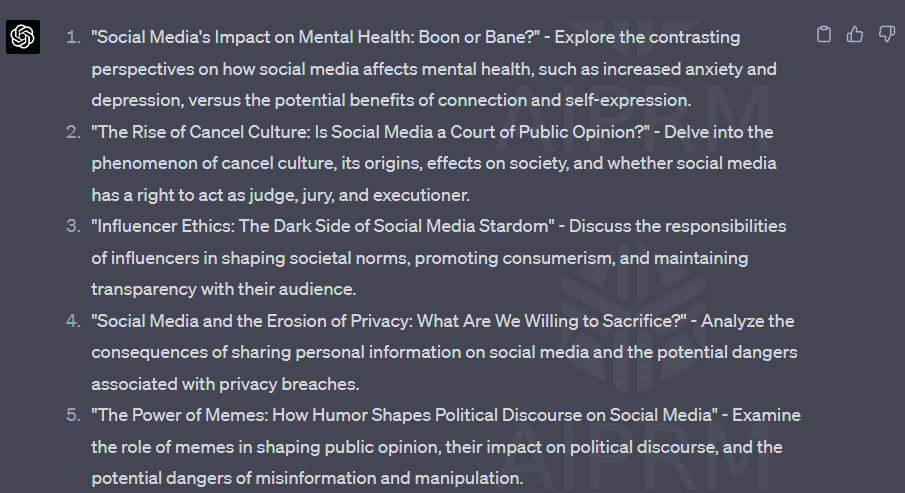
And that's how you can arrive at a topic such as social media and mental health.
Next, narrow it down.
Ask ChatGPT: “I will write an essay on social media and mental health. Help me narrow this topic down so I can focus on a specific perspective. What are the best perspectives to focus on?”

Lastly, let's formulate the argument. For this essay, I like the idea of explicitly focusing on the impact of excessive social media usage on mental well-being, specifically within the teenage demographic.
Voila – here's the thesis: Excessive social media use can lead to negative consequences on mental health.
Building Compelling Arguments

Mastering the art of essay structuring involves addressing a reader's logic and guiding them through your argument like a well-orchestrated conversation.
Imagine each essay section as a response to the reader's questions arising from your thesis (later, we’ll explain how to use ChatGPT for this).
First, the “what” question: What evidence supports the phenomenon described by your thesis? This is the foundation of your argument, where you present the facts and observations that validate your claim.
In the early part of your essay, typically following the introduction, you'll present the evidence demonstrating your claim's truth. However, avoid letting this section consume more than a third of your essay; otherwise, your argument may lack balance and come across as a summary.
Now, onto the “how”: How does the thesis stand up to counterarguments? Your readers will want to know if your claims are valid in all cases. To address this, you must examine your argument from multiple angles, considering alternative viewpoints and potential challenges.
In your essay, include at least one “how” section to respond to your reader's complicating questions. While this section often follows the “what.” You can include it in another place as long as you address the reader's logic.
Finally, the “why” question: Why does your interpretation of a phenomenon matter? This crucial component allows your readers to understand the larger implications of your argument.
By answering “why,” you explain the significance of your essay within a broader context. Although you might hint at this question in your introduction, the most comprehensive answer should appear at the end of your essay.
Neglecting to address this question may leave your readers feeling that your essay is unfinished or, worse, irrelevant.
How to Use ChatGPT to Build a Compelling Argument

Remember: our job is to fashion coherent ideas into an argument that caters to the reader's logic.
So, how can you utilize ChatGPT to that end?
Let's explore a strategy that connects this guiding principle with the power of ChatGPT.
Once you have your thesis, present it to ChatGPT as a prompt, asking for potential questions that a reader may have upon reading it.
Here's what I used:
I'm building an essay, and my thesis statement is, [insert thesis statement].”
I want to map out different essay sections to answer questions my reader might ask when encountering my thesis. What questions would typical readers have as they read this thesis? These questions should be enough to structure a full academic essay.
Here's what ChatGPT generated:

Next, analyze the questions generated by ChatGPT and group them into the main categories that your essay will address: the “what,” “how,” and “why” components.
In essence, this would form the outline of your essay.
Supporting Evidence
Now, let's use ChatGPT to brainstorm ideas for supporting evidence. Begin with a prompt that targets the evidence you need to strengthen your argument.
For example, you might ask: “What evidence can I find to support the claim that excessive social media use can increase anxiety and depression in teenagers?”

Now, remember not to take ChatGPT's suggestions as gospel. Instead, you'll want to dive into some manual research to ensure you're using accurate information.
Use Google to find reliable sources like academic journals, books, and websites supporting these points. And don't forget to check for newer research beyond 2021!
Building Counterarguments

In crafting a persuasive essay, it's crucial to address counterarguments effectively. This involves two key stages: challenging your argument and then reaffirming it.
First, put yourself in the shoes of a skeptical reader or reference a source that might contest your argument.
Here's where you can identify potential issues, such as:
- Alternative conclusions
- Unwarranted assumptions
- Overlooked evidence
Create a prompt encouraging ChatGPT to consider new perspectives, evidence, or sources that could impact your argument.
For example:
“How would the introduction of new evidence or alternative perspectives affect my argument that ‘[insert your thesis here]'?”
ChatGPT gave us insight into specific counter-evidence and contextual factors that could challenge your thesis.

You could also try “What are some counterarguments to my thesis: ‘[insert your thesis here]'?” or “What are the potential weaknesses and alternative perspectives on my argument that ‘[insert your thesis here]'?”
Check out the gems ChatGPT provided!
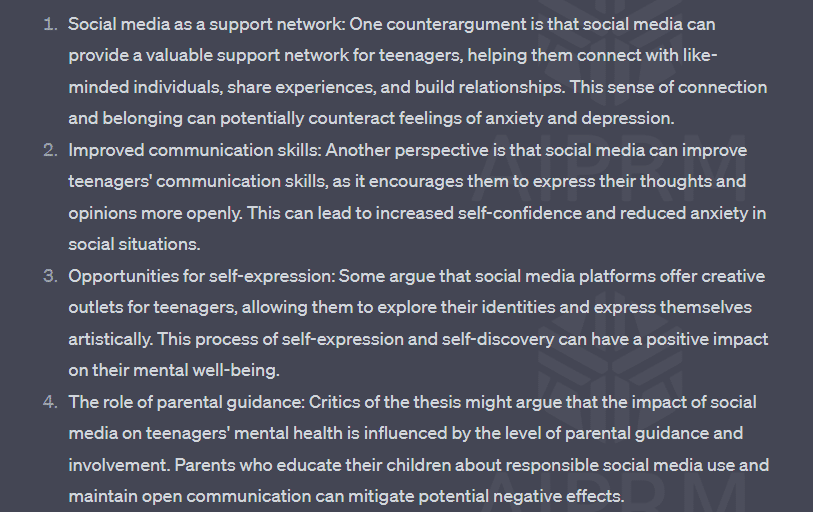
Integrating Counterarguments
After you gather your counterarguments from ChatGPT, it's time to integrate them into your essay.
To introduce them, use phrases like “One might argue that…” or “It could be said that…”. Then, present the opposing view clearly and convincingly, being mindful to avoid weak or insincere counterarguments.
Next, return to your original argument, pivoting with phrases like “However,” “Nevertheless,” or “Still.”
When responding to the counterargument, consider these approaches:
- Disprove it, demonstrating that the issue isn’t a genuine concern.
- Acknowledge its merit but argue that it doesn't outweigh your main argument.
Pro Tip: You can even use the above bullet points as instructions for ChatGPT.
Enhancing Creativity with ChatGPT
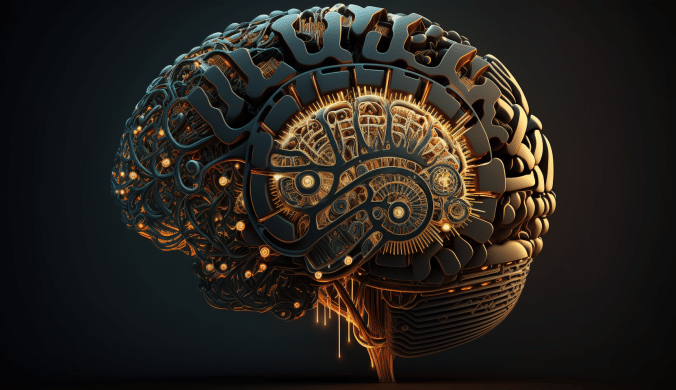
Did you know that ChatGPT has the remarkable ability to mimic virtually any writing tone?
Imagine captivating your readers with the thought-provoking tone of Malcolm Gladwell.
First, dive into Gladwell's work and identify the elements that make his writing stand out.
What captures your attention, and how does he keep you hooked? List your findings to create a roadmap for emulating his style.
Armed with your observations, it's time to craft a specific prompt for ChatGPT.
Remember, the secret to unlocking the desired output lies in the clarity of your request.
You might ask, “Could you help me write an introduction to my essay on [your topic] that mirrors Malcolm Gladwell's signature style, compelling storytelling, and unique sentence structure?”
How To Use ChatGPT For Essays – Final Thoughts
To wrap it up, the era of AI-powered essay writing is here, thanks to the remarkable abilities of ChatGPT.
As we march forward into the future, there's enormous potential for AI to fortify writers in their creative pursuits.
Mastering the art of deploying ChatGPT for ideation, honing compelling thesis statements, forming convincing arguments, and even capturing the essence of our esteemed authors enables us to level up our writing while sparing precious resources.
With a mindful approach, the fusion of AI and human ingenuity promises a bright future for essay writing.
Frequently Asked Questions (FAQs)
You may have more questions about how to use ChatGPT for essays:
How Can I Ensure the Originality of my Essay Using ChatGPT?
Start with a clear and unique thesis statement or research question. Then use ChatGPT to generate ideas, gather information, and find supporting evidence, but avoid relying solely on the generated text. Make sure you paraphrase, restructure, and combine the information with your own insights. Lastly, run your essay through plagiarism detection software like Grammarly.
The post How To Use ChatGPT For Essays: Write Better Assignments Faster appeared first on Niche Pursuits.

